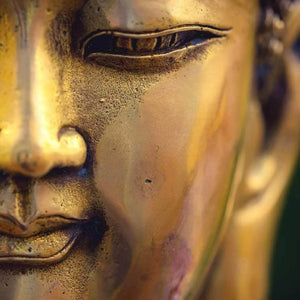
Ametyst armbånd m/ 6 mm ametystkuler
Ametyst armbånd m/ 6 mm ametystkuler
Vakkert armbånd av halvedelstenen Ametyst.

AMETHYST
Power & Protection
Det er en lang tradisjon for å gi bergarter en symbolsk verdi til å la det påvirke underbevisstheten og ubevisste tendenser inne i oss,og sammen med kraften som alle levende ting (inkludert steiner) innehar gjør steinene til gode verktøy for vår egen personlig vekst og selvrealisering.
Mange tror at slike steiner og krystaller har forskjellige overnaturlige eller helbredende krefter, andre avfeier dette som overtro. Du kan velge en stein for seg selv. Slapp av og vær deg selv. Du kan lukke øynene, men du kan også ha øynene åpne, men ikke fokusere på annet utenfor deg selv.
Varen blir plukket tilfeldig fra de vi måtte ha på lager, se bildet for eksempel på hvordan de kan se ut. Farger og mønster på hver stein varierer -hver bit er unik.
* Ovennevnte opplysninger er ikke anerkjent vitenskapelig, men er basert på erfaringer og resultater fra brukere og terapeuter. Eventuelle helbredende egenskaper er ikke ment å være substituert eller behandlet av en kvalifisert terapeut eller lege.
Amethyst is a semi-precious stone, which is known for centuries and is commonly used in jewelry purposes. The stone is basically in purple and violet shade. Amethyst is popularly known as the birthstone of February. It is one of the various forms of quartz crystal. It is available in many countries around the world.
However, the quality of amethyst gemstone is different according to the areas and its origin. The name Amethyst is derived from the Greek word 'amethustos', saying "not drunken". The origin of amethyst name and its healing properties is originated from a history of Greek mythology. Since antiquity, amethyst stone was used as a gemstone by the ancient Egyptians, they used it for intaglio engraved gems. According to Greek, amethyst gems were useful in intoxication, during the medieval times amulets made of amethyst were wore by European soldiers for their protection in battle. They believed that amethysts help in healing as well as to keep people cool headed. The stone was also found in Anglo-Saxon graves in England.
Amethyst was actually used as a strong antidote against drunkenness that is why wine goblets were carved with this stone. According to a Greek myth, it is said that the Greek God Dionysus became angry with the insult of a mortal and swore to slay the next mortal that crossed the following path, creating fierce tigers to carry out his anger. Dionysus met a beautiful young Amethystos who worshipped God Diana, who was on his way to pay tribute to Artemis. Her life was saved by Artemis, who transformed the maiden into a statue of pure crystalline quartz to protect her from the brutal claws. Dionysus wept tears of wine in regret for his action at the sight of the beautiful statue. Tears of God then stained the quartz purple that is the semi-precious stone of present day.
Amethyst is naturally available in clusters in a nodular stone. It is sometimes found in volcanic or small cavities in rocks. Amethyst color obtained by a combination of manganese and iron impurities. The purple color is due to the availability of manganese, while the existence of iron controls the intensity of color. Amethyst is found in different types of sizes and shapes. This semi-precious stone is unique in color. Amethyst gemstone belong to the quartz family and it consist of colors ranging from lilac to deep purple, including a reddish sometimes. The most valuable quality of amethyst used in jewelry is the stone with the dark shade and is transparent. It may fade in tone if it is highly exposed to sources which are light and they can be can be artificially darkened with suitable irradiation.
Amethyst is the most precious and valuable stone belonging to the quartz group of minerals, having the feature of rare blue-green gem silica. It is well-known as the official birthstone for the month of February. Amethyst comes from the microcrystalline branch of quartz with the presence of violet/purple color to iron and aluminum impurities. If these coloring agents were not present, then amethyst stone is transparent and ordinary colorless quartz. Like other variations in microcrystalline quartz, amethyst has transparent to translucent clarity and the luster is vitreous. Cryptocrystalline quartz are mainly found in clarity in translucent form to opaque.
In the British Crown we find fine amethysts embossed, it turned out to be a favorite of Catherine the Great and Egyptian royalty. Amethyst ranked high in the Christian church and was named "the stone of bishops".
Recognise - Amethyst stone in artificial light never show its best color. In daylight the amethyst stone gives the best look; more exactly, a little bit after sunrise or just before sunset when the light is soft and warm. Amethyst is discern with violet-purple colors. The best examples must possess a deep purple color and good saturation with minimal color zoning.
Availability - Major deposits of amethyst are in Brazil, such as the "Palmeira" category from Rio Grande do Sul and the availability of "Maraba" from Para. Other places where amethyst deposits are found are Bolivia, Canada, India, Madagascar, Mexico, Myanmar (Burma), Namibia, Russia, Sri Lanka, United States (Arizona), Uruguay and African continent.
Usages - Amethyst is one of the most popular gems. It is used in rings, earrings, bracelets, pendants, et al. It is found in vibrant color and is commonly used gem that makes it an inexpensive and wide use gem. Mainly the Amethyst is faceted into jewelry cuts, and some of them are cut into cabochons. Many times amethyst banded with quartz and available in huge masses are designed in various ornaments. Amethyst is famous among the mineral collectors. The amateur collectors buy the tumbled stones including the small geode, whereas the serious collectors look for prismatic crystals which is rare and giant geode sections.
Buying Guide
Color - The color in the Amethyst is because of iron and aluminum impurities. The colors are available in wide variety from purple and violet to pale red-violet. The deep colors are precious especially rich purple carrying the rose flashes. "Siberian" with amethyst in deep purple color with red and blue flashes carrying the highest prices with the amethyst. The green amethyst is manufactured with heat treatment, however as the amethyst is defined by its purple color in case of green colored amethyst it is not a true amethyst.
Clarity and Lustre - Fine amethyst is found transparent meaning the light without any hindrance get passes through the stone. In case of translucent amethyst there is slight weak passage of light as it travels through the stone. Top most quality amethyst is clean as well as free of visible presences of any kind. Amethyst stone is found in plenty that is why hardly there is any cause to buy visible inclusions.
Cut and Shape - To maximize the color the cut is in brilliant rounds and ovals because the variability of the distribution of color in the amethyst crystals. In the en cabochon the amethyst is cut is very rare. It is popular in other shapes and modified cutting styles, however, only amethyst specimens having good color distribution are cut into fancy stones. Amethyst is found in almost every shape, size and cut. Calibrated sizes are simply available in different fancy shapes such as hearts, trillions and shields are very common. Amethyst is used as ornamental carvings these days, therefore artisans work to produce beautiful amethyst carvings.
Treatment - Naturally, the amethyst quartz is not treated. There are amethyst stones that are enhanced while heating, however when we heat amethyst stone it reduces coloring agents and result in 'heated citrine'. Heat treatment of 878ºF to 1382ºF will typically yield red-brown, green, light-yellow or colorless results.

